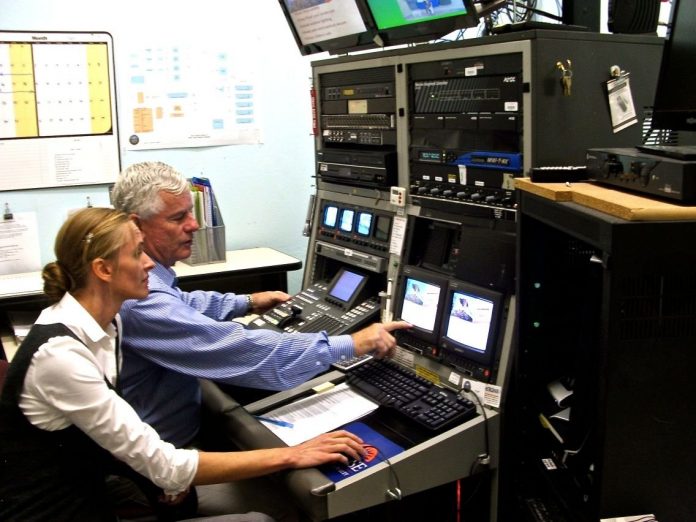
GILROY—Jaime Rosso believes it’s time to live-stream meetings of the elected officials who make all decisions about Gilroy classrooms, teacher salaries, school construction, bond measures and a whole lot more.
And that would be Rosso and his six colleagues on the Gilroy Unified School District Board of Trustees. The board’s meetings, every other Thursday, have never been broadcast live.
“It has been suggested that it’s time for the school board to provide live broadcasting,” Rosso told the Oct. 22 board meeting.
“In contemplating the benefits [of live broadcasts] I would like to suggest just such a proposal,” he said.
The suggestion that the board start live broadcasts was made in an Oct. 16 Dispatch editorial, which pointed out that while the district found the time and money to build a $158 million high school [Christopher], it had not found enough of either to broadcast meetings live to the community.
Rosso said that now is the time to “explore the options and consider streaming live future board meetings” because the district is considering upgrades to the board chambers on Arroyo Circle.
Rosso, who has championed technology in classrooms, instructed Superintendent Debbie Flores to put the matter on an upcoming board agenda.
Flores responded that she is adding it to her list of items for discussion. No date was set at the meeting, but this week Flores told the Dispatch that the Executive Committee of the Board (Board President, Vice President and Superintendent) “met this morning (Oct 28) at 7 am and we decided to schedule the item regarding live broadcasting board meetings on November 19, 2015.”
Flores continued, “From my viewpoint, live broadcasting of Board meetings is a Board level decision. In anticipation of the Board discussion on Nov. 19, staff will pull together information that may be helpful for their deliberations e.g. the costs of live broadcasting, the technical implementation of live broadcasting, and what other districts in the county do. If the Board decides to broadcast meetings live, staff will quickly work to make this happen.”
If Rosso’s idea meets with board approval, the GUSD would be the second elected body in Gilroy to live-stream meetings. The other is the Gilroy City Council.
Gavilan Community College does not broadcast its meetings live to residents of the district, who live in Morgan Hill, San Martin, Gilroy and San Benito County.
A list of questions sent last week by the Dispatch to members of the Gilroy board about the live broadcast of meetings received response from Rosso and board president James Pace.
Rosso responded, “I do believe this is in the public interest subject to financial limitations,” adding he had asked the matter be put on a future agenda for discussion.
Pace wrote in his email response: “In keeping with the Brown Act, the best place for each board member to provide their thoughts and input is at a meeting of the full board where notice has been provided to the public that this discussion will take place. I will work with the superintendent to place this matter on an upcoming agenda, as Mr. Rosso mentioned.”
If the district begins live broadcasts, they will come a quarter-century after the city of Gilroy began the practice around 1990, then upgraded to live streaming.
“The biggest positive change in this area was the implementation of video streaming in 2003,” Gilroy public information officer Joe Kline told the Dispatch.
“Prior to that, the meeting could only be viewed by cable subscribers on their television sets. With streaming, anyone with a computer or mobile device [can view meetings],” he said.
“Additionally, archived meetings, back to 2003, can be viewed online, and viewers can zero in on specific agenda items merely by selecting that item on the accompanying agenda. Since this service has become available, requests for CDs or DVDs has dropped almost to zero,” Kline said.
He also said that since he is a paid employee, there is no additional labor cost to live-streaming meetings, which is also done by the city planning commission.
“There is no annual budget specific to broadcasting. Periodically capital money is allocated for hardware, camera replacement, etc. We are now all digital so there are not the operational costs for video tapes, VCRs, etc. that there used to be,” Kline explained.
“I have an annual budget of $2,000 for contractual services. If I need to get a technician in to service or adjust equipment, I use that cost center,” he said.
At Gavilan College, spokesperson Jan Bernstein Chargin said the school has no plans to broadcast trustee meeting live to the public. The school used to rebroadcast recordings of the meetings via a community access channel.
The reason live broadcasting is not done is mostly financial, she suggested.
“There is an expense involved in broadcasting live, staff and technology requirements,” she wrote in an email to the Dispatch.
She said Gavilan once broadcast live a special meeting in San Benito County, via CMAP (Community Media Access Partnership), which the city of Gilroy also used for broadcasts early on.
Bernstein Chargin added, “Other meetings have been taped by members of the public for CMAP depending upon their interest. For 10 years Gavilan had a dedicated channel on CMAP (GavTV-18) where parts of board meetings would occasionally be taped and shown, depending upon what was happening and the interest of the students in the TV classes. When Christopher High School opened, CMAP moved there, and GavTV-18 ceased operation,” she said.
At the Gilroy school headquarters, Superintendent Debbie Flores said that district board meetings also used to be rebroadcast using DVDs, but no longer.
“We cannot confirm when the rebroadcast of board meetings started, although we think it was around 2007-2008. They ended about 18 months ago due to technical difficulties that despite hours of staff time trying to resolve, could not be resolved,” she wrote in an email to the Dispatch.














